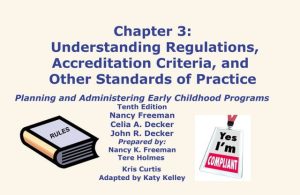In this article, we will delve into the process of course accredited for continuing education, highlight its benefits, and guide you on practical steps to achieve it successfully.
Imagine the immense value of offering a course that not only imparts valuable knowledge but also grants participants continuing education credits. Whether you belong to the academic realm, work as a training coordinator, or possess expertise in a specific field as an entrepreneur, obtaining accreditation for your course in continuing education opens doors to a whole new world of opportunities.
Understanding Accreditation for Continuing Education:
Continuing education plays a pivotal role in professional development, enabling individuals to expand their knowledge, skills, and expertise beyond traditional classroom settings. Accreditation certifies the quality and relevance of these educational offerings. When a course is accredited, it signifies that it meets the rigorous standards set by accrediting bodies or regulatory organizations. Accreditation not only attests to the course’s quality but also assures participants that their investment of time and money will yield valuable learning outcomes and recognized credentials.
The Benefits of Accreditation:
Course accreditation for continuing education brings forth numerous benefits for both course providers and participants. Let us delve into some of the primary benefits. In doing so, we aim to provide a comprehensive overview of the advantages at hand.
- Credibility: Accreditation bestows credibility upon your course, validating its quality and enhancing its reputation in the eyes of potential participants.
- Marketability: Accreditation sets you apart in a saturated market, differentiating your course from competitors. It appeals to individuals seeking reputable and recognized programs.
- Professional Growth: By obtaining accreditation, course providers demonstrate their unwavering commitment to excellence and professionalism. It also motivates constant improvement and evolution of course content to meet industry standards.
- Transferability: Accredited courses often permit participants to transfer earned credits toward higher education programs or professional certifications, expanding their access to further educational opportunities.
Steps to Accredit Your Course for Continuing Education:
Step 1: Identify Accrediting Bodies:
The initial step involves researching and identifying accrediting bodies or regulatory organizations that align with your course’s subject matter. Each field may have specific accrediting bodies tailored to its unique requirements. For instance, healthcare courses may pursue accreditation from medical or nursing associations, whereas business courses may seek recognition from professional organizations like the American Management Association
Step 2: Understand Accreditation Criteria:
To meet accreditation criteria, it is crucial to grasp the requirements stipulated by the identified accrediting bodies. These criteria encompass various aspects such as course content, instructional methods, instructor qualifications, and assessment strategies. Thoroughly study the criteria and align your course design accordingly. Adhering to the specific guidelines set by accrediting bodies significantly enhances your chances of success.
Step 3: Course Development and Alignment:
To ensure your course meets accreditation requirements, develop comprehensive course materials that align with the identified criteria. Pay keen attention to the following elements:
Course Objectives and Learning Outcomes:
Clearly define your course objectives and outline the intended learning outcomes for participants. These should correspond to the specific knowledge and skills expected by accrediting bodies.
Curriculum Design:
Design the curriculum to encompass essential content areas specified by accrediting bodies. Ensure logical flow and consider incorporating multimedia elements to enhance engagement and comprehension.
Instructional Methods:
Choose instructional methods that are both effective and aligned with accreditation criteria. Employ a mix of lectures, interactive activities, case studies, discussions, and assessments to ensure participants achieve desired learning outcomes.
Instructor Qualifications:
Verify that your instructors possess the necessary qualifications indicated by accrediting bodies. This may involve academic degrees, professional certifications, or practical experience in the subject matter.
Step 4: Course Review and Quality Assurance:
Before submitting your course for accreditation, conduct an internal review to ensure it meets the highest standards. Seek feedback from subject matter experts or peers to identify areas for improvement. Pay special attention to:
Content Accuracy and Relevance:
Thoroughly review your course materials to ensure the accuracy of the provided information. Continuously update content to remain relevant to industry practices and standards.
Instructional Design and Clarity:
Evaluate the clarity and effectiveness of your instructional design. Strive to present complex concepts clearly and understandably, facilitating participants’ learning process.
Step 5: Documentation and Application Submission:
Once confident that your course meets accreditation criteria and has undergone internal review, gather all the required documentation specified by accrediting bodies. This documentation may include course outlines, learning objectives, instructor qualifications, and assessments. Proceed to complete the application process diligently, accurately furnishing all necessary information.
Step 6: Accreditation Review and Feedback:
Upon submitting your application, the accrediting body will initiate a thorough review process. This typically includes an in-depth assessment of your documentation, course materials, and occasionally even a site visit. Be prepared to address any additional queries or requests for further information promptly. The review duration may vary depending on the accrediting body.
Step 7: Accreditation Maintenance:
Once your course obtains accreditation, it becomes imperative to maintain compliance with ongoing requirements established by accrediting bodies. This may involve periodic reviews, assessments, or updates to ensure your course consistently aligns with evolving industry standards.
Conclusion:
Achieving accreditation for your course in continuing education is a remarkable accomplishment that unlocks a world of opportunities for both course providers and participants. By comprehending the accreditation process, identifying relevant accrediting bodies, and satisfying their criteria, you can offer a course that not only imparts knowledge but also provides participants with valuable and recognized credentials. Embrace the process, diligently develop your course, and open doors to professional growth and educational excellence.
Related Post How to Study in the UK and Excel Academically
Author’s Note: Remember, accreditation is not merely a stamp of approval; it symbolizes your unwavering commitment to delivering quality education.
Sources:
- American Council on Education – www.acenet.edu
- The Accreditation Council for Continuing Medical Education.- www.accme.org
- National Association of State Boards of Accountancy – www.nasba.org










